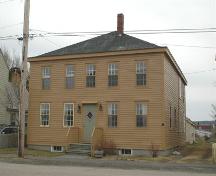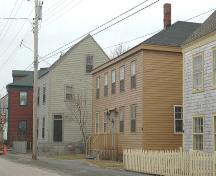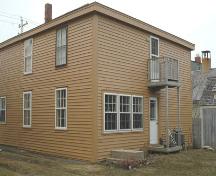158 St. George Street
158 St. George Street, Annapolis Royal, Nova Scotia, B0S 1A0, Canada
Formally Recognized: 1982/01/20
Other Name(s)
Bonnett House
Links and Documents
Listed on the Canadian Register: 2007/03/09
Statement of Significance
Description of Historic Place
The Bonnett House, located at 158 St. George Street, Annapolis Royal, NS, is a two-storey wood frame structure built circa 1773 in the Neo-classical style. It features a five bay façade clad in wooden clapboard with a medium hipped roof. Built facing the waterfront, it is situated close to the street, in a grouping of four similar eighteenth century houses, the only such grouping remaining in Annapolis Royal. The municipal designation includes the house and property.Heritage Value
The Bonnett House, as recognized by its municipal designation, is valued for its association with history of the town, age, and architecture.Historic Value:
At the turn of the seventeenth century, this lot was part of the property of Jean Chrysostome Loppinot who was the royal notary for the Acadie colony who had arrived in Port Royal in 1699. M. Loppinot married Jeanne Doucet, and Acadian, and by 1704 was attorney general and representative for the French Admiralty. Their first house was burned in June 1707 during an assault on the town. Their second, reconstructed, home was destroyed by fire on the night of June 7, 1710 when a shipment of cotton being stored in the building ignited.
As a French civil servant Loppinot forfeited his property and was obliged to return to France after the surrender of the town in 1710 to the British after the Treaty of Utrecht. In 1732 the lot was part of that granted by the British Crown to John Hanshole, a native of Alsace who was stationed with the British garrison and served as constable to the governing council. He too married an Acadian woman, Marie Daigre dit Oulozon, in 1727. The builder of the Bonnett House, Pardon Sanders, purchased the lot in 1764. Sanders was an artificer with the Board of Ordnance who had come to the area in the 1740s to work on Fort Anne. His job ended in 1769 when the Ordnance establishment at the fort was terminated. He continued to live in the town and built the Bonnett House shortly thereafter. Through the science of dendrochronology, the house has been dated at 1773.
In 1783, at the height of the Loyalist migration to town, Sanders sold the property to newcomer Frederic Davoue, a Loyalist from New Rochelle, New York, who was a prominent land speculator. The following year Davoue sold the portion of the lot containing the house to fellow Loyalist, merchant David Bonnett. The Bonnett House was then owned by his sons Isaac Bonnett, a merchant, and Peter Bonnett, High Sheriff, until its purchase in 1853 by merchant Charles Starratt. From 1930 until 1990 it was the home of the Burrell and related Brothers families.
Architectural Value:
The Bonnett House is significant for its age and its symmetrical Neo-classical features. It is a two-storey house located close to the street with a medium hip roof, five bays on the street façade and a central chimney. The cornice is boxed and plain, with the exception of the street façade, which has decorative moulding under the roof projection. The central door has a plain wood head and sides, with a decorative crown. The exterior walls are wood clapboarding with end boards. In 1992 an extension was added to the back of the house which almost squares the building. At that time, artificial siding and modern windows were replaced with the current wooden features.
The Bonnett House is an important contributor to this part of lower St. George Street as it is Annapolis Royal's longest surviving streetscape. It is also notable that it is located across the street from the town's waterfront with a view of the neighbouring community of Granville Ferry.
Source: Town of Annapolis Royal Heritage Designation Files
Character-defining Elements
Character defining elements of the Bonnett house include:- location close to road edge and in an area of other heritage buildings;
- facing and close to the town's waterfront;
- medium hip roof;
- decorative roof trim on front façade;
- symmetrical positioning of windows on front façade;
- simple door and window trim;
- decorative crown over central door;
- six-over-six wooden double hung sash windows;
- wooden clapboard siding.
Recognition
Jurisdiction
Nova Scotia
Recognition Authority
Local Governments (NS)
Recognition Statute
Heritage Property Act
Recognition Type
Municipally Registered Property
Recognition Date
1982/01/20
Historical Information
Theme - Category and Type
Expressing Intellectual and Cultural Life
Architecture and Design
Peopling the Land
Settlement
Function - Category and Type
Historic
Residence
Single Dwelling
Builder
Sanders, Pardon
Additional Information
Location of Supporting Documentation
Heritage Property Files, Town Hall, 285 St.George Street, Annapolis Royal, Nova Scotia
FED/PROV/TERR Identifier
02MNS2176











